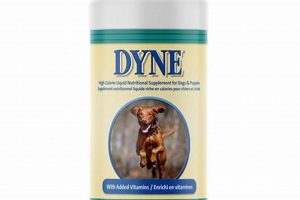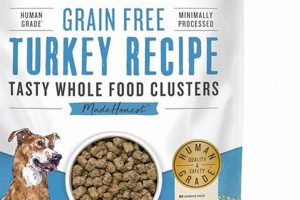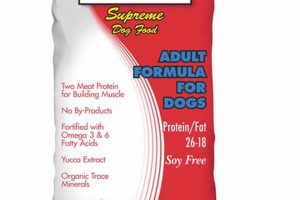A standardized component affixed to packaged processed meat products provides details pertaining to its composition, nutritional content, and manufacturer. This informational tool allows consumers to make informed purchasing decisions based on dietary needs, allergen concerns, and ingredient preferences. As an example, this attached item may explicitly declare the presence of mechanically separated chicken, sodium nitrite, and specific spices within the encased meat product.
Its significance lies in promoting transparency within the food industry and enabling consumers to actively manage their health and well-being. Historically, the implementation of these standards has evolved in response to increased consumer awareness and demand for greater accountability from food producers. Adherence to regulatory guidelines ensures that these details are accurate and readily available, fostering trust and mitigating potential risks associated with undeclared ingredients or misleading claims.
The following sections will further analyze the specific elements found within this informational guide, examine relevant regulations, and address common consumer inquiries regarding the selection and interpretation of this crucial data.
Decoding Product Information
Navigating the intricacies of processed meat packaging can empower informed consumption. The following guidelines offer clarity when evaluating these pre-packaged items.
Tip 1: Scrutinize the Ingredient List. Components are listed in descending order by weight. Prioritize products where meat comprises a substantial portion of the initial ingredients.
Tip 2: Evaluate Sodium Content. High sodium levels correlate with potential health risks. Compare products and opt for lower sodium alternatives whenever feasible.
Tip 3: Understand Additives and Preservatives. Research unfamiliar chemical names. Certain additives, while approved, may trigger sensitivities in specific individuals.
Tip 4: Examine Nutritional Information. Pay close attention to saturated fat, trans fat, and cholesterol content. Maintaining awareness of these values contributes to responsible dietary choices.
Tip 5: Verify Manufacturing Details. Identify the manufacturer and location of production. This information provides a means of contacting the producer with inquiries or concerns.
Tip 6: Note the “Use By” or “Sell By” Date. This date indicates the product’s optimal quality and safety. Adhering to these dates minimizes the risk of foodborne illness.
By applying these strategies, consumers can leverage provided details to align purchasing decisions with their dietary requirements and personal preferences.
The subsequent sections will delve deeper into regulatory frameworks and common misconceptions surrounding processed meat product data.
1. Ingredient declaration
The ingredient declaration is a mandatory component of packaged food items, including processed meat products. It serves as a detailed listing of all substances intentionally added to the food, arranged in descending order by weight. Within the context of processed meat product packaging, this listing provides critical insight into the product’s composition, extending beyond the basic identification of the primary meat source. For instance, a “hot dog food label” must declare not only the type of meat used (e.g., beef, pork, chicken) but also any added water, binders (such as corn syrup or modified food starch), preservatives (like sodium nitrite), flavorings (spices, artificial flavors), and coloring agents. The accuracy and completeness of this declaration are regulated by food safety agencies to protect consumers from misrepresentation and potential health risks.
The inclusion of an accurate ingredient declaration on a processed meat product empowers consumers to make informed choices aligned with dietary restrictions, allergies, or personal preferences. Individuals with sodium sensitivities can identify products with lower sodium content. Those avoiding specific additives, such as artificial sweeteners or colorings, can utilize the declaration to select appropriate options. The arrangement of ingredients by weight also allows consumers to assess the relative proportions of different components, impacting the overall nutritional profile and sensory characteristics of the product. For example, if water is listed as the first ingredient, it indicates that the product contains a significant amount of added water, which may affect its flavor and texture.
In conclusion, the ingredient declaration is an indispensable element of processed meat packaging. Its function extends beyond simple identification, providing vital information about product composition, potential allergens, and the presence of additives. This transparency allows consumers to actively participate in their dietary decisions, mitigating risks associated with undisclosed ingredients and promoting healthier food choices.
2. Nutritional information
The nutritional information panel on processed meat products, such as encased sausages, is a critical component providing consumers with essential data regarding the product’s nutrient content. This panel delineates the levels of various macronutrients (fat, protein, carbohydrates), micronutrients (vitamins and minerals), and other components like sodium and cholesterol, typically presented per serving size. The accuracy and completeness of this information are directly linked to informed dietary choices, allowing individuals to manage their intake of specific nutrients and make healthier decisions based on their individual needs or dietary restrictions.
The presence of the nutritional information on a processed meat product directly impacts the consumer’s ability to assess the product’s suitability within a balanced diet. For example, a processed meat product with high levels of saturated fat and sodium, as indicated on the panel, may pose health risks for individuals with cardiovascular concerns or hypertension. Conversely, the protein content detailed on the panel can be a determining factor for those seeking to increase their protein intake. The practical significance of understanding this data extends to managing caloric intake, controlling portion sizes, and selecting products that align with specific dietary goals, such as weight management or athletic performance.
In summary, the nutritional information panel is an indispensable tool for consumers navigating the processed meat product landscape. Its presence facilitates informed decision-making by providing quantifiable data on nutrient content, thereby enabling individuals to prioritize health and make responsible dietary choices. Challenges remain in ensuring consumer understanding of the information presented, as well as maintaining the accuracy and integrity of the data provided by manufacturers. This data is an indispensable part of the processed meat product composition.
3. Allergen warnings
The presence of allergen warnings on processed meat product packaging, specifically regarding encased meat products, constitutes a critical element in safeguarding consumer health and mitigating potential adverse reactions. Accurate and conspicuous allergen labeling is mandated by regulatory bodies and represents a fundamental responsibility of food manufacturers.
- Mandatory Declaration of Common Allergens
Food labeling regulations typically require the declaration of specific allergenic ingredients that are known to cause significant allergic reactions in sensitive individuals. Common examples include milk, eggs, fish, shellfish, tree nuts, peanuts, wheat, and soy. If these ingredients, or derivatives thereof, are present in a processed meat product, they must be clearly identified on the packaging. For example, a processed meat product casing might contain hydrolyzed vegetable protein derived from soy, necessitating its inclusion in the allergen warning.
- Cross-Contamination Considerations
Beyond the intentional inclusion of allergenic ingredients, potential cross-contamination during manufacturing processes poses a significant risk. Even if a processed meat product is not formulated with a specific allergen, it may be exposed to that allergen during production, packaging, or handling. In such cases, precautionary allergen labeling, such as “may contain [allergen]” or “produced in a facility that also processes [allergen],” is often employed to inform consumers of the potential risk.
- Impact on Consumer Choice and Safety
Accurate and comprehensive allergen warnings empower consumers with known allergies to make informed purchasing decisions. By carefully scrutinizing ingredient lists and allergen statements, individuals can avoid products that pose a risk of triggering an allergic reaction. The absence or misrepresentation of allergen information can have severe consequences, ranging from mild discomfort to life-threatening anaphylaxis.
- Legal and Regulatory Compliance
Failure to comply with allergen labeling regulations can result in significant legal and financial penalties for food manufacturers. Regulatory agencies conduct routine inspections and audits to ensure adherence to labeling requirements. Furthermore, consumer advocacy groups and individual lawsuits can hold manufacturers accountable for inaccurate or misleading allergen information.
In summation, the accurate and prominent display of allergen warnings on processed meat products is essential for protecting vulnerable consumers and upholding ethical manufacturing practices. Robust allergen control programs, coupled with transparent labeling, are critical for fostering trust and mitigating the potential for adverse health outcomes.
4. Manufacturer details
The inclusion of manufacturer details on processed meat product packaging, particularly pertaining to encased meat products, is a fundamental aspect of food traceability and consumer protection. This information, typically comprising the manufacturer’s name, address, and contact information, serves as a vital link between the product and its origin, facilitating accountability and enabling consumers to seek redress or clarification regarding product-related issues.
- Traceability and Accountability
Manufacturer details enable authorities to trace the origin of products in the event of foodborne illness outbreaks or product recalls. Accurate identification of the manufacturer allows for swift containment of affected products and prevents further distribution. Furthermore, this information holds manufacturers accountable for product safety and quality, incentivizing adherence to stringent production standards. For example, if a batch of encased meat products is found to be contaminated with Listeria, the manufacturer’s information facilitates rapid identification and removal of the affected products from the market.
- Consumer Redress and Inquiries
The provision of manufacturer contact information allows consumers to directly address inquiries, complaints, or concerns regarding the processed meat product. This direct line of communication fosters transparency and enables manufacturers to respond to consumer feedback, improving product quality and building consumer trust. For instance, a consumer observing inconsistent texture or off-flavor in an encased meat product can contact the manufacturer to report the issue and seek clarification regarding potential causes.
- Verification of Production Standards
Manufacturer details can be used by consumers or third-party auditors to verify compliance with relevant food safety regulations and certifications. By researching the manufacturer, consumers can ascertain whether the production facility adheres to standards such as Hazard Analysis and Critical Control Points (HACCP) or possesses certifications from recognized organizations. This verification process empowers consumers to make informed purchasing decisions based on the manufacturer’s commitment to food safety and quality.
- Facilitating Product Recalls
In the event of a product recall, manufacturer details are essential for effectively communicating the recall information to consumers and retailers. Clear and accessible manufacturer contact information enables consumers to obtain recall instructions, identify affected products, and seek appropriate compensation. The prompt and efficient dissemination of recall information is crucial for minimizing potential health risks associated with contaminated or misbranded products.
In summary, the inclusion of comprehensive manufacturer details on processed meat product packaging is indispensable for ensuring traceability, accountability, and consumer protection. This information empowers consumers to make informed choices, seek redress for product-related issues, and verify compliance with food safety standards, ultimately fostering a more transparent and responsible food industry. The manufacturer details enable consumer empowerment to make informed choices.
5. Weight Statement
The weight statement, prominently displayed on the product details, serves as a critical piece of information on processed meat products, including those containing encased meats. It denotes the net quantity of the product contained within the packaging, providing consumers with a standardized measure for comparison and purchase decisions. This declaration is subject to regulatory oversight to ensure accuracy and prevent misleading claims.
- Standardized Unit of Measure
The weight statement provides a standardized unit of measure, typically expressed in grams (g) or ounces (oz), allowing consumers to compare the quantity of product offered by different brands or product variations. This standardization is essential for making informed value comparisons. For instance, a consumer may use the weight statement to determine which product offers the greatest quantity for a given price point. The statement must accurately reflect the contents, with allowable tolerances defined by regulatory bodies.
- Basis for Nutritional Information
The weight statement serves as the foundation for calculating per-serving nutritional information provided elsewhere on the product details. Nutritional values, such as calories, fat, and sodium, are typically presented per serving, and the serving size is directly related to the total weight of the product. Discrepancies between the stated weight and actual weight can therefore impact the accuracy of the nutritional information, potentially leading to misinformed dietary choices. Regulators use statistical sampling to make sure the weight stated on the details matches the contents inside.
- Indicator of Product Value
Consumers often utilize the weight statement as a primary factor in determining the perceived value of a processed meat product. A larger weight declaration may be interpreted as a better value proposition, influencing purchase decisions. However, it is crucial to consider other factors, such as ingredient quality, nutritional content, and manufacturing practices, in addition to weight when evaluating overall product value. Consumers may compare products with lower weight with good ingredients to products with high weight but bad ingredients.
- Regulatory Compliance and Enforcement
The accuracy of the weight statement is subject to stringent regulatory oversight by governmental agencies responsible for consumer protection and fair trade practices. These agencies conduct inspections and audits to verify that the declared weight accurately reflects the net quantity of product within the packaging. Violations of weight statement regulations can result in significant penalties, including fines, product recalls, and legal action. Consumers should be aware of this weight data to protect them.
The weight statement, therefore, plays a multifaceted role in the context of encased meat food details. It provides a standardized unit of measure, informs nutritional calculations, influences value perceptions, and is subject to regulatory compliance. A thorough understanding of its function is crucial for consumers seeking to make informed and responsible purchasing decisions.
Frequently Asked Questions
The following section addresses common inquiries regarding the interpretation and significance of the data presented on encased meat product packaging.
Question 1: What is the primary purpose of the ingredient declaration on a processed meat product?
The ingredient declaration provides a comprehensive listing of all components intentionally added to the food, arranged in descending order by weight. This allows consumers to identify specific ingredients, assess potential allergens, and evaluate the product’s overall composition.
Question 2: How should nutritional information be utilized when selecting processed meat products?
Nutritional information provides quantifiable data on macronutrient (fat, protein, carbohydrates) and micronutrient (vitamins, minerals) content, enabling consumers to make informed choices based on dietary needs and health considerations. Sodium and saturated fat levels are particularly important factors to evaluate.
Question 3: What is the significance of allergen warnings on encased meat product packaging?
Allergen warnings alert consumers to the presence of ingredients known to cause allergic reactions in sensitive individuals. Strict adherence to these warnings is crucial for preventing potentially life-threatening allergic responses.
Question 4: Why is it important to note the manufacturer details on a processed meat product?
Manufacturer details provide traceability and accountability, allowing consumers to contact the manufacturer with inquiries, complaints, or concerns. This information also facilitates product recalls and enables verification of production standards.
Question 5: How does the weight statement influence purchasing decisions?
The weight statement provides a standardized unit of measure for comparing the quantity of product offered by different brands or product variations. It also serves as the basis for calculating per-serving nutritional information.
Question 6: What regulatory bodies oversee the accuracy and completeness of data on processed meat products?
Governmental agencies, such as food safety authorities, are responsible for enforcing labeling regulations and ensuring that the information presented on processed meat products is accurate and not misleading. These agencies conduct inspections and audits to verify compliance.
Accurate interpretation of encased meat packaging is crucial for informed decision-making and promoting responsible dietary choices. Consumers are encouraged to carefully review all available data and consult with healthcare professionals for personalized dietary guidance.
The concluding section will summarize the key considerations for navigating processed meat product data and emphasize the importance of ongoing consumer education.
Conclusion
The analysis of information on encased meat products reveals the critical role this attached standard plays in consumer decision-making. The ingredient declarations, nutritional information, allergen warnings, manufacturer details, and weight statements collectively empower individuals to make informed choices aligned with their dietary needs, health concerns, and ethical considerations. Regulatory oversight ensures a degree of accuracy and standardization; however, ongoing consumer vigilance is essential for navigating the complexities of this food packaging. Knowledge is power, which is the first step to protect consumer in this kind of processed food.
As dietary guidelines evolve and consumer awareness increases, the standards for processed meat products will likely face greater scrutiny and demands for enhanced transparency. Continued education and critical evaluation of the information available are paramount. These steps can help to prevent false information to arise and protect consumer health and rights, as the label has a power to help the consumer.







![Best Dog Food Roll: Healthy & Convenient [Guide] World’s Most Delicious Foods: Must-Try Dishes from Every Country Best Dog Food Roll: Healthy & Convenient [Guide] | World’s Most Delicious Foods: Must-Try Dishes from Every Country](https://lisasfoods.com/wp-content/uploads/2025/12/th-651-300x200.jpg)